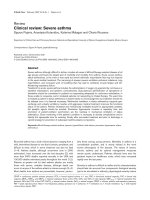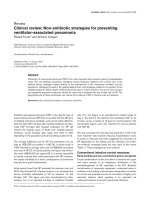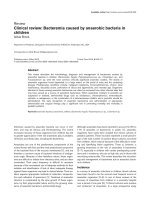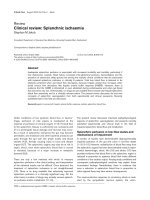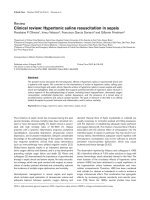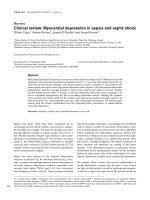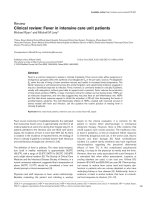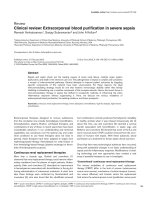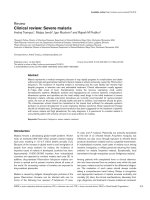Báo cáo y học: "Clinical review: Extracorporeal blood purification in severe sepsis" pdf
Bạn đang xem bản rút gọn của tài liệu. Xem và tải ngay bản đầy đủ của tài liệu tại đây (68.44 KB, 7 trang )
139
ARF = acute renal failure; CHFD = continuous high-flux dialysis; CRRT = continuous renal replacement therapy; CVVH = continuous veno-venous
hemofiltration; HVHF = high-volume hemofiltration; IL = interleukin; TNF = tumor necrosis factor.
Available online />Extracorporeal therapies designed to remove substances
from the circulation now include hemodialysis, hemofiltration,
hemoadsorption, plasma filtration, cell-based therapies, and
combinations of any of these. In recent years there have been
considerable advances in our understanding and technical
capabilities, but consensus over the optimal way and under
what conditions to use these therapies does not exist. In
general, these therapies have been adapted to sepsis from
nephrology-based therapy (hemodialysis for renal failure) or
from hematology-based therapy (plasma exchange for throm-
botic thrombocytopenic purpura).
Continuous renal replacement therapies
More than a decade ago, Gotloib and coworkers [1]
observed that renal replacement therapy could remove inflam-
matory mediators from the plasma of septic patients. Subse-
quently, Stein and coworkers [2] described an improvement
in hemodynamics associated with hemofiltration in the pig fol-
lowing administration of intravenous endotoxin. A short time
later these findings were confirmed by Grootendorst and
coworkers [3], who also found that the ultrafiltrate removed
from endotoxemic animals produced hemodynamic instability
in healthy animals when it was infused intravenously [4]. At
about this time, Lee and coworkers [5] reported a survival
benefit associated with hemofiltration in septic pigs and
Bellomo and coworkers [6] showed that some of the ILs and
tumor necrosis factor (TNF) could be removed from the circu-
lation of humans with sepsis. With these advances, blood
purification as a treatment for human septic shock was born.
Since that time many technological advances have occurred,
along with substantial changes in our basic understanding of
sepsis and the inflammatory response. Modifications of exist-
ing technology and new approaches have created a vast
array of possible therapies to use or investigate.
‘Conventional’ continuous renal replacement therapy
The various modalities of continuous renal replacement
therapy (CRRT) differ in the kind of access (arteriovenous
versus veno-venous), mechanism of solute transport (convec-
tive versus diffusive), and location where the replacement
fluid enters the extracorporeal circuit (predilution versus post-
Review
Clinical review: Extracorporeal blood purification in severe sepsis
Ramesh Venkataraman
1
, Sanjay Subramanian
2
and John A Kellum
3
1
Visiting Instructor, Department of Critical Care Medicine, University of Pittsburgh School of Medicine, Pittsburgh, Pennsylvania, USA
2
Staff Intensivist, Department of Medicine, Musselshell Medical Center, Roundup, Montana, USA
3
Associate Professor, Department of Critical Care Medicine, University of Pittsburgh School of Medicine, Pittsburgh, Pennsylvania, USA
Correspondence: John A Kellum,
Published online: 21 February 2003 Critical Care 2003, 7:139-145 (DOI 10.1186/cc1889)
This article is online at />© 2003 BioMed Central Ltd (Print ISSN 1364-8535; Online ISSN 1466-609X)
Abstract
Sepsis and septic shock are the leading causes of acute renal failure, multiple organ system
dysfunction, and death in the intensive care unit. The pathogenesis of sepsis is complex and comprises
a mosaic of interconnected pathways. Several attempts to improve patient outcomes by targeting
specific components of this network have been unsuccessful. For these reasons, the ideal
immunomodulating strategy would be one that restores immunologic stability rather than blindly
inhibiting or stimulating one or another component of this complex network. Hence, the recent focus of
immunomodulatory therapy in sepsis has shifted to nonspecific methods of influencing the entire
inflammatory response without suppressing it. Here, we discuss the various modalities of
extracorporeal blood purification, the existing evidence, and future prospects.
Keywords continuous renal replacement therapy, hemo-adsorption, hemofiltration, high-flux dialysis, high-volume
hemofiltration
140
Critical Care April 2003 Vol 7 No 2 Venkataraman et al.
dilution). In arteriovenous circuits blood is driven by the
patient’s blood pressure through a filter, via an extracorporeal
circuit originating from an artery and terminating in a vein.
However, in a veno-venous circuit, blood is driven by a peri-
staltic pump module (with appropriate air bubble and pres-
sure monitors) through a filter via an extracorporeal circuit
originating and terminating in a vein. Arteriovenous circuits
carry all of the risks associated with arterial puncture (i.e.
thrombosis, bleeding, etc.) and are disadvantageous in that
the ultrafiltration and solute clearance are dependent on the
patient’s blood pressure and their efficiency is unpredictable
[7]. For these reasons, veno-venous circuits using double-
lumen catheters are considered safer and more efficient, and
are now widely preferred in the management of renal failure.
Given that the system requirements are only greater with
immunomodulation, arteriovenous systems have been aban-
doned in the treatment of sepsis.
The term ‘diffusion’ describes a type of solute transport
across a semipermeable membrane generated by a concen-
tration gradient. The extent of diffusive clearance is deter-
mined by the molecular weight of the solute (or more
precisely by the Einstein–Stokes radius of the molecule), the
concentration gradient across the membrane, temperature,
and the membrane surface area, thickness and pore size.
Smaller solutes such as urea, creatinine, and electrolytes are
cleared efficiently by diffusion, and as a solute’s molecular
weight increases diffusivity decreases. During CRRT the
addition of countercurrent dialysate flow accomplishes diffu-
sive clearance by maximizing the concentration gradient
between blood and dialysate through the length of the mem-
brane. The term ‘convection’ describes a process in which
solutes are transported across a semipermeable membrane,
along with movement of solvent (ultrafiltration) that occurs in
response to a positive transmembrane pressure gradient.
Here, the clearance depends on the ultrafiltration rate and
sieving characteristics of the membrane and solute, and to a
lesser extent on the molecular size of the solute. Dialysis
membranes are further classified based on their ultrafiltration
coefficients into high-flux and low-flux membranes (i.e. for a
given transmembrane pressure gradient, high-flux membranes
have a higher filtration rate than do low-flux membranes).
There are few data to state convincingly that convective clear-
ance is better than diffusive clearance. However, studies
comparing convective clearance and diffusive clearance have
shown that middle-molecular-weight substances (peptides)
and large molecules such as vancomycin are better removed
by convection [8–10]. Some of the molecules implicated in
sepsis and multiple organ dysfunction fall into the middle-
molecular-weight range, and hence convective therapy may
serve as a useful adjunctive therapy in septic shock [9]. In
addition, convective treatments permit isotonic ultrafiltration,
whereas in diffusive treatments osmotic changes in plasma
may produce unwanted fluid shifts toward the intracellular
compartment.
The nomenclature of the CRRT modality depends on the type
of access (arteriovenous versus veno-venous) and the mech-
anism of solute clearance used. If the clearance is purely dif-
fusive then the term ‘hemodialysis’ is used, and if the
clearance is purely convective then the term ‘hemofiltration’ is
used. When both convective and diffusive clearances are
used, the term ‘hemodiafiltration’ is applied. Continuous
hemodiafiltration – a combination of convective and diffusive
clearance – is the most efficient CRRT modality. In modalities
that involve convective clearance, the ultrafiltrate produced
during membrane transit is replaced completely or in part
with a replacement solution to achieve volume control and
blood purification. Ultrafiltration in excess of replacement
results in patient weight loss [11]. The replacement fluid can
be infused either before the filter (predilution) or after the filter
(postdilution). The efficiency of postdilution CRRT is limited
by the maximum acceptable value of filtration fraction and by
the maximal blood flow that can be delivered by the access.
Conversely, predilution CRRT is not limited by filtration frac-
tion and therefore allows for higher ultrafiltration rates. This,
along with increased replacement fluid rate and a more
porous membrane, can enhance solute clearance. However,
at a given ultrafiltration rate, predilution results in reduced
solute clearance as compared with postdilution because of
dilution of solutes at blood entry into the filter. Hence, ultrafil-
tration must be relatively increased to maintain the same effi-
ciency of solute removal as is observed in postdilution mode
[12–14]. Although definitive evidence is lacking, predilution
fluid replacement also is believed to enhance filter patency
during CRRT and to reduce need for anticoagulation [15].
Along with a surge in proinflammatory mediators, there is a
parallel rise in anti-inflammatory substances in sepsis, which
creates a state of ‘immunoparalysis’ that is characterized by
immune effector cell (i.e. monocyte) dysfunction [16]. Both
the proinflammatory and anti-inflammatory cascades interact
with each other, and form a complex network that is con-
stantly trying to balance and restore immunologic homeosta-
sis [17]. Numerous therapies designed to intervene in the
proinflammatory cascade alone have failed to alter the
outcome of sepsis in recent years [18]. Hence, the recent
focus of immunomodulatory therapy in sepsis has shifted to
nonspecifically downregulating the entire inflammatory
response without suppressing it, perhaps by using extracor-
poreal blood purification techniques. The rationale for such a
strategy is that it would ‘autoregulate’ itself, such that as one
component of the response increases, so too would the
effect on that component [19].
Most of the immune mediators are water soluble and fall into
the middle-molecular-weight category [20] and hence can
theoretically be removed by a plasma water purification
system such as hemofiltration. Based on the above rationale
and observations, several investigators have studied the
effects of CRRT in animal models of sepsis and have demon-
strated some beneficial effects [21]. Subsequently, Kellum
141
and coworkers [9] demonstrated that, although convective
clearance (continuous veno-venous hemofiltration [CVVH])
was better than diffusion (continuous veno-venous hemodialy-
sis) in reducing plasma TNF, the mode of clearance did not
influence plasma concentrations of IL-6, IL-10, soluble
L-selectin, or endotoxin. However, in a small clinical trial of
early isovolemic CVVH at 2 l/hour, Cole and coworkers [22]
were unable to demonstrate any reduction in the circulating
concentrations of several cytokines and anaphylatoxins asso-
ciated with septic shock, or could they show improved organ
dysfunction following severe sepsis. Thus, the relative impact
of conventional CRRT on inflammatory molecules is probably
small and the impact on clinical outcomes uncertain. Hence,
conventional CRRT is currently not recommended as a
therapy for sepsis in patients without renal failure [14].
High-volume hemofiltration
Wide variation exists in the manner in which CRRT is pre-
scribed worldwide. Although higher effluent flow rates are
sometimes prescribed in Europe and Australia, because of
the limitations of pump design, effluent flow rates during
CRRT in the USA have traditionally been restricted to 2 l/hour
or less. Recently, however, Ronco and coworkers [23]
showed that higher CRRT doses (35 ml/kg per min) improved
patient survival in acute renal failure (ARF) as compared with
conventional doses (20 ml/kg per min), whereas further
increases in dose to 45 ml/kg per min were not helpful.
Because sepsis is a major cause or complicating factor asso-
ciated with the development of ARF as well as mortality in
this population, it is intriguing to speculate that increased
inflammatory mediator removal with convection may have
played a role in improving survival. Confirmation of this
hypothesis awaits further large studies.
Although most of the inflammatory mediator molecules fall
into the middle-molecular-weight category and can theoret-
ically be removed by hemofiltration, they have very high
generation rates relative to uremic toxins. Thus, the inten-
sity of blood purification and the beneficial effects have
been relatively modest with the traditionally used effluent
flow rates of 1–2 l/hour (as used for management of ARF)
[9,22]. Subsequently, investigators seeking to achieve
‘adequate blood purification’ in sepsis hypothesized that
higher ultrafiltration rates would be necessary. Defined by
an ultrafiltration flow rate in excess of 35 ml/kg per hour
and often as high as 75–120 ml/kg per hour [15], high-
volume hemofiltration (HVHF) may be necessary to achieve
‘clinically meaningful’ convective removal of inflammatory
mediators. To achieve HVHF, it is necessary to use a high
permeability membrane with a large surface area and
sieving coefficient close to 1 for a wide spectrum of molec-
ular weights.
Numerous in vitro and animal studies have shown that syn-
thetic filters used in hemofiltration can extract a wide array of
substances that are involved in sepsis to a certain degree
[24]. Early studies conducted by Grootendorst and cowork-
ers [3,4] using porcine endotoxic models showed a major
attenuation of endotoxin-induced hypotension and an
improvement in cardiac performance with HVHF. Subsequent
animal studies also showed similar beneficial effects with
HVHF in endotoxic animal models [25,26]. These animal find-
ings subsequently triggered some interest in the potential
benefits of HVHF in human sepsis. HVHF has been shown to
improve hemodynamics, decrease vasopressor requirement
and perhaps improve survival in septic patients [27–30].
However, those studies were all done in either small number
of patients or were nonrandomized and uncontrolled. Despite
these early promising studies, larger trials looking at HVHF as
an adjunctive therapy in human sepsis are needed before
such therapy can be routinely advocated.
Continuous high-flux dialysis
Extending previous work on nomenclature for CRRT, the Defi-
nitions Workgroup for the Acute Dialysis Quality Initiative
defined continuous high-flux dialysis (CHFD) as a form of
CRRT that uses a highly permeable dialyzer with blood and
dialysate flowing countercurrent, and in which ultrafiltrate pro-
duction is controlled by blood pumps whereby there is a
balance of filtration and backfiltration, with ultrafiltrate pro-
duced in the proximal portion of the fibers and reinfused by
backfiltration in the distal portion of the fibers so that replace-
ment fluid is not required [15]. This technique has mainly been
developed to optimize the clearance of middle molecules
without compromising the clearance of urea nitrogen. Another
feature seen in some systems is an addition of a gravimetric
pump in the ultrafiltration/dialysate outflow limb. This regulates
both the net ultrafiltration rate and the dialysate outflow rate.
Once the patient’s dry weight has been reached, the circuit
may operate at zero net filtration using dialysate at varying flow
rates to provide back filtration in the distal limb of the circuit
equal in amount to the ultrafiltrate generated in the proximal
limb. In this mode, convective transport is therefore maintained
without any need for replacement fluids [31]. Since this tech-
nique combines convective and diffusive clearances, urea
clearances of up to 60 l/day and middle molecule clearance
(specifically inulin) of up to 36 l/day have been demonstrated.
There is very limited data on the use of CHFD as a mode of
blood purification in human sepsis. Lonneman and coworkers
[32] compared the effects of standard CVVH with CHFD on
ex vivo induced whole blood production of TNF and inhibitory
TNF soluble receptor type I in 12 patients with sepsis and
ARF. That study showed an increase in TNF production with
time during CHFD as compared with CVVH and a significant
increase in soluble receptor concentration in the dialysate
during CHFD.
Hemo-adsorption
Although uncontrolled clinical studies of HVHF suggest that
hemodynamic variables and even survival might be improved
[30], the optimal flow rate to achieve ‘adequate’ clearance of
Available online />142
inflammatory mediators has yet to be determined. Further-
more, the application of HVHF routinely in humans raises sub-
stantial organizational, technical, and financial issues.
Removal rates and clearances of the different inflammatory
cytokines (e.g. TNF, IL-1, etc.) are limited by poor membrane
passage and may be further reduced over time as the mem-
brane becomes ‘fouled’ by plasma proteins. However, there is
also evidence that clearance of mediators by hemofiltration
may be due more to adsorption of mediators to the mem-
brane, although convective clearance is still partly responsi-
ble [33,34].
Hence, in the quest to achieve higher mediator clearance,
newer membranes/devices with higher porosity and adsorp-
tive capacity have been tried. ‘Hemoperfusion’ is a technique
in which a sorbent is placed in direct contact with blood in an
extracorporeal circuit. Nonspecific adsorbents, typically char-
coal and resins, attract solutes through a variety of forces,
including hydrophobic interactions, ionic (or electrostatic)
attraction, hydrogen bonding, and van der Waals interactions.
By manipulating the porous structure of solid phase sorbents,
it is possible to increase the selectivity of nonspecific adsor-
bents for particular solutes. In this case, solute molecules are
separated according to their size and by their ability to pene-
trate the porous network of the sorbent material [35]. The
adsorptive capacity for resins and charcoals is often quite
high, in excess of 500 m
2
/g adsorbent. Until recently, poor
biocompatibility, as evidenced by thrombocytopenia and neu-
tropenia [36], was the major clinical limitation of these materi-
als. Newer resin adsorbents appear to have resolved this
issue with the addition of a biocompatible coating [37]. In
view of the high-molecular-weight adsorption characteristics
of sorbents, it is possible to target larger molecules that
exceed the molecular weight cutoff of synthetic high-flux dial-
ysis membranes. This makes sorbents potentially ideal for
intervention in sepsis. Sorbents have been applied in different
treatment modalities, including hemoperfusion and hemoper-
fusion coupled with hemodialysis or with plasma filtration. The
choice of modality is based mainly on the properties of the
sorbent and the technique used.
In Gram-negative sepsis, lipopolysaccharide and its frag-
ments are instrumental in the initiation and perpetuation of the
inflammatory response. Therefore, earlier extracorporeal
devices were designed to remove the inciting stimulus (i.e.
endotoxin). Attempts have been made to remove endotoxin
from the circulation using polymyxin-B-immobilized fiber and
charcoal hemoperfusion. Hemoperfusion with polymyxin-B-
bound sepharose, immobilized with fiber, has been shown to
have positive effects in an animal model of normotensive
sepsis [38]. Subsequently, human studies have demon-
strated that treatment with polymyxin-B-immobilized fiber
reduces plasma levels of endotoxin, thrombomodulin, TNF
release, and endothelin-1 levels in septic shock [39,40]. In a
pilot study (n = 16), Aoki and coworkers [41] showed that
hemoperfusion with polymyxin-B-immobilized fiber signifi-
cantly decreased endotoxin levels after 2 hours of direct
hemoperfusion. Those investigators also showed that the
hyperdynamic, high cardiac output state returned to normal
levels after treatment, and in patients with arterial systolic
pressure below 100 mmHg the pressure increased signifi-
cantly from the pretreatment level. Fever was also alleviated
by this therapy and did not return until the day after treatment.
Nonetheless, no randomized controlled studies yet exist to
support the effectiveness of this strategy in managing sepsis.
Various other sorbents have been designed and used for
blood purification, but are currently in the clinical testing
phase. One such system is the molecular adsorbent regener-
ating system device, which employs a polysulfone high-per-
meability dialyzer with albumin on the dialysate side to aid
transfer of protein-bound toxins across the membranes [42].
This system has mainly been used in the treatment of hepatic
encephalopathy and fulminant hepatic failure, and good clini-
cal studies in septic patients are lacking at the present time.
One of the techniques of hemo-adsorption is to separate the
plasma from the blood using a plasma filter and then passing
the filtered plasma through a synthetic resin cartridge, ulti-
mately returning it to the blood. A second filter can be added
to remove excess fluid and low-molecular-weight toxins. The
use of a more open membrane (plasmafilter) coupled with
adsorption may increase the adsorptive capacity of the
system and achieve higher nonspecific clearance of inflam-
matory mediators [43]. Tetta and coworkers demonstrated
both significant removal of both proinflammatory and anti-
inflammatory mediators [44] and improved survival [45] using
this technique in an animal model of sepsis. Subsequently, in
a recent pilot study Ronco and coworkers [46] documented
important physiologic benefits (hemodynamic stability and
monocyte responsiveness) using this technique in septic
patients. Using hemoperfusion with a different sorbent
(CytoSorb™), in a lethal animal model of lipopolysaccharide-
induced shock we recently demonstrated improved hemo-
dynamics and survival time, along with significant decreases
in plasma IL-6 and IL-10 levels, using hemoadsorption [47].
The above studies support a role for broad-spectrum hemo-
adsorption of multiple inflammatory substances to augment
the management of sepsis. These therapies offer new
promise in the field of immunomodulation because they are
both broad-spectrum (removing both proinflammatory and
anti-inflammatory substances) and self-regulating (they
remove substances in relation to their circulating concentra-
tions) [48]. Broad-spectrum adsorption offers significant
advantages over hemofiltration and is simpler to apply than
plasmapheresis. Currently, extensive preclinical work is being
undertaken to define the duration of therapy with sorbents,
the timing of application, and device design [35].
Plasma therapies in critically ill patients
Although the terms ‘plasmapheresis’ and ‘plasma exchange’
are commonly used synonymously, the two techniques differ
Critical Care April 2003 Vol 7 No 2 Venkataraman et al.
143
in important ways. Plasmapheresis is a two-step process in
which first the separation of blood into its components (cells
and plasma) is accomplished, by means of a centrifugal pump
or filter. Then, the separated plasma is allowed to flow along
column(s) containing different adsorbents, allowing the selec-
tive removal of components, and the processed plasma is
reinfused back to the patient. Hence, in plasmapheresis no
(or minimal) replacement fluids are necessary. By contrast,
plasma exchange is a single-step process in which blood is
separated into plasma and cells similarly using centrifugation
pumps or a filter, and the cells are returned back to the
patient while the plasma is replaced with either donor plasma
or albumin [49]. Replacing volume lost with fresh frozen
plasma is also done to replete any factor(s) (immunoglobu-
lins, etc.) necessary to restore homeostasis and often to
correct the underlying disorder for which the plasma therapy
was done in the first place (e.g. thrombotic thrombocytopenic
purpura). Plasma filtration has advantages over centrifugal
plasma exchange in that it is less expensive and can be per-
formed with the same machines as are used for CRRT.
Like other extracorporeal blood purification techniques,
plasma therapies have been tried in the treatment of sepsis.
Early animal studies done to evaluate efficacy in altering the
inflammatory response have provided conflicting results
[50–52]. In early human studies, plasma exchange has been
shown to reduce effectively the plasma concentrations of
various sepsis mediators [53–55]. However, wide variation
exists in the pattern of mediator removal. For example, in a
study conducted by Gardlund and coworkers [54], plasma
exchange therapy in septic patients decreased the plasma
levels of TNF but not of other cytokines. In contrast, Reeves
and coworkers [56] showed that a wide variety of acute
phase proteins and complement fragment C
3
can effectively
be removed by plasma exchange therapy in septic patients.
However, in that study plasmafiltration did not influence mean
concentrations of IL-6, granulocyte colony-stimulating factor,
thromboxane B
2
, total white cell count, neutrophil count, or
platelet count. There was also no improvement in survival with
plasmafiltration in that study.
Independent of the specific mediators removed, plasma
exchange therapy has been shown to be associated with
improvement in hemodynamic variables in some clinical
studies [57–59]. However, all of those studies were limited in
that they studied small numbers of patients and were uncon-
trolled. In septic patients (n = 12), Berlot and coworkers [59]
showed that the cardiac index improved significantly after
plasma exchange therapy (aimed at removing the full volume
of plasma). Interestingly, this improvement in cardiac index
was not associated with any changes in preload or afterload.
However, the improvement in hemodynamic variables was
transient and had no effect on the outcome of these patients.
Furthermore, patients in the study received plasma replace-
ment, and hence it is difficult to infer whether these changes
in hemodynamic variables were due to removal of mediators
or due to the replacement substances present in the donor
plasma. In patients with septic shock, Ronco and coworkers
[46] showed that coupled plasmafiltration–adsorption com-
bined with hemodialysis was associated with improvement in
hemodynamics and leukocyte responsiveness as compared
with treatment with continuous veno-venous hemodiafiltration.
Finally, in a recent retrospective observational study (n = 7),
Ataman and coworkers [60] failed to demonstrate any signifi-
cant improvement in cardiovascular parameters (heart rate
and mean arterial pressure) during the first 24 hours after
plasmapheresis.
In a retrospective study looking at outcomes in patients with
sepsis treated with plasma exchange therapy, Barzilay and
coworkers [61] showed that patients treated with hemodiafil-
tration associated with plasma exchange had a better survival
than did patients treated with conventional hemofiltration or
hemodiafiltration without any plasma exchange therapy.
Patients who did not receive any blood purification therapy
(control group) had the worst outcome. However, that retro-
spective study has numerous study design limitations (i.e. it
was nonrandomized, underpowered, and the different treat-
ment groups were not comparable to each other). Subse-
quently, in another nonrandomized study, 19 septic patients
who underwent CVVH combined with plasmapheresis were
compared with 24 patients who had been treated for their
sepsis without any blood purification technique [62].
Although in that study the treatment group had an overall
lower mortality than did the control group (42.1% versus
45.8%), the primary organ failure rates were higher in the
treatment group.
Some authors have argued that plasma therapies are most
likely to be effective when they are applied after early stabi-
lization of shock and perhaps when targeting thrombotic
microangiopathy rather than cytokines [63]. Most recently,
Busund and colleagues [64] used partial plasma exchange
therapy and showed a tendency toward improve outcome in
adult patients with septic shock. Finally, in a preliminary
report, Nguyen and colleagues [65] reported that children
with thrombocytopenia (platelet count <100 000/mm
3
)-asso-
ciated multiple organ failure had reduced or absent von Willi-
brand factor cleaving protease activity, along with markedly
increased plasminogen activator inhibitor-1 activity, both of
which were reversed by plasma exchange therapy. These
patients required a median of 11 days of plasma exchange to
reverse their multiple organ failure. These findings suggest
that prolonged plasma exchange may be required to reverse
the thrombotic microangiopathy of thrombocytopenia-associ-
ated sepsis as well. Hence, outcomes with plasma exchange
therapy may also be related to duration of treatment and the
presence of underlying thrombotic microangiopathy. Thus,
based on the limited and conflicting data available, it is diffi-
cult to know whether plasma exchange will be useful in the
management of sepsis, either alone or in combination with
other forms of blood purification. These techniques are also
Available online />144
more cumbersome and costly than other forms of extracorpo-
real blood purification (i.e. HVHF and hemo-adsorption).
However, the results of recent studies, especially those in
patients with sepsis-associated thrombotic microangiopathy,
argue in favor of larger clinical trials.
Conclusion
Although this wider approach to blood purification in sepsis
seems logical, promising and opens new perspectives, many
questions still remain unanswered, including the timing, dura-
tion, and frequency of these therapies in the clinical setting.
However, for now one can safely conclude that these tech-
niques are usually well tolerated and are effective in clearing
‘mediators’ of sepsis from the plasma, often improving physio-
logic parameters. Large multicenter trials evaluating their effi-
cacy to improve clinical outcomes (i.e. mortality or organ
failure), rather than surrogate markers such as plasma media-
tor clearance or transient improvement in physiologic vari-
ables, are required to define the precise role of these
therapies in the management of sepsis. Given the available
data to date, we speculate that immunomodulation using
either HVHF or hemo-adsorption, or both, will be most useful
in the early stages of severe sepsis and septic shock when
high levels of inflammatory mediators appear in the circula-
tion, whereas plasma therapies will be most useful later in the
course of illness when thrombotic microangiopathy and
endothelial injury begin to immerge. The most effective blood
purification strategy may be the careful deployment of both of
these therapies at right time.
Competing interests
RV and JK have received research grants from Renaltech
International and Gambro.
Acknowledgements
As well as the affiliations listed at the top of the article, all authors are
also from the “Clinical Research, Investigation, and Systems Modeling
of Acute illness Laboratory” (CRISMA Laboratory), Pittsburgh, USA.
References
1. Gotloib L, Barzilay E, Shustak A, Wais Z, Jaichenko J, Lev A:
Hemofiltration in septic ARDS. The artificial kidney as an arti-
ficial endocrine lung. Resuscitation 1986, 13:123-132.
2. Stein B, Pfenninger E, Grunert A, Schmitz JE, Hudde M: Influ-
ence of continuous haemofiltration on haemodynamics and
central blood volume in experimental endotoxic shock. Inten-
sive Care Med 1990, 16:494-499.
3. Grootendorst AF, van Bommel EF, van der Hoven B, van Leen-
goed LA, van Osta AL: High volume hemofiltration improves
right ventricular function in endotoxin-induced shock in the
pig. Intensive Care Med 1992, 18:235-240.
4. Grootendorst AF, van Bommel EF, van Leengoed LA, van Zanten
AR, Huipen HJ, Groeneveld AB: Infusion of ultrafiltrate from
endotoxemic pigs depresses myocardial performance in
normal pigs. J Crit Care 1993, 8:161-169.
5. Lee PA, Matson JR, Pryor RW, Hinshaw LB: Continuous arteri-
ovenous hemofiltration therapy for Staphylococcus aureus-
induced septicemia in immature swine. Crit Care Med 1993,
21:914-924.
6. Bellomo R, Tipping P, Boyce N: Continuous veno-venous
hemofiltration with dialysis removes cytokines from the circu-
lation of septic patients. Crit Care Med 1993, 21:522-526.
7. Bellomo R, Parkin G, Love J, Boyce N: A prospective compara-
tive study of continuous arteriovenous hemodiafiltration and
continuous venovenous hemodiafiltration in critically ill
patients. Am J Kidney Dis 1993, 21:400-404.
8. Jeffrey RF, Khan AA, Prabhu P, Todd N, Goutcher E, Will EJ,
Davison AM: A comparison of molecular clearance rates
during continuous hemofiltration and hemodialysis with a
novel volumetric continuous renal replacement system. Artif
Organs 1994, 18:425-428.
9. Kellum JA, Johnson JP, Kramer D, Palevsky P, Brady JJ, Pinsky
MR: Diffusive vs. convective therapy: effects on mediators of
inflammation in patient with severe systemic inflammatory
response syndrome. Crit Care Med 1998, 26:1995-2000.
10. Brunet S, Leblanc M, Geadah D, Parent D, Courteau S, Cardinal
J: Diffusive and convective solute clearances during continu-
ous renal replacement therapy at various dialysate and ultra-
filtration flow rates. Am J Kidney Dis 1999, 34:486-492.
11. Ronco R, Bellomo R: Nomenclature for continuous renal
replacement therapies. In Critical Care Nephrology. Edited by
Ronco R, Bellomo R. Boston: Kluwer Academic Publishers;
1998:1169-1176.
12. Lebedo I: Predilution hemofiltration: a new technology applied
to an old therapy! Int J Artif Organs 1995, 18:735-742.
13. Ficheux A, Argiles A, Bosc JY, Mion C: Analysis of the influence
of the infusion site on dialyser clearances measured in an in
vitro system mimicking haemodialysis and haemodiafiltration.
Blood Purif 1999, 17:10-18.
14. Kellum JA, Mehta RL, Angus DC, Palevsky P, Ronco C: The first
international consensus conference on continuous renal
replacement therapy. Kidney Int 2002, 62:1855-1863.
15. Acute Dialysis Quality Initiative. []
16. Adib-Conquy M, Adrie C, Moine P, Asehnoune K, Fitting C, Pinsky
MR, Dhainaut JF, Cavaillon JM: NF-kappaB expression in
mononuclear cells of patients with sepsis resembles that
observed in lipopolysaccharide tolerance. Am J Respir Crit
Care Med 2000, 162:1877-1883.
17. Adrie C, Pinsky MR: The inflammatory balance in human
sepsis. Intensive Care Med 2000, 26:364-375.
18. Abraham E, Matthay MA, Dinarello CA, Vincent JL, Cohen J, Opal
SM, Glauser M, Parsons P, Fisher CJ Jr, Repine JE: Consensus
conference definitions for sepsis, septic shock, acute lung
injury, and acute respiratory distress syndrome: time for a
reevaluation. Crit Care Med 2000, 28:232-235.
19. Kellum JA, Venkataraman R: Blood purification in sepsis: an
idea whose time has come? Crit Care Med 2002, 30:1387-
1388.
20. von Andrian UH, Mackay CR: T-cell function and migration. Two
sides of the same coin. N Engl J Med 2000, 343:1020-1034.
21. Gomez A, Wang R, Unruh H, Light RB, Bose D, Chau T, Correa
E, Mink S: hemofiltration reverses left ventricular dysfunction
during sepsis in dogs. Anesthesiology 1990, 73:671-685.
22. Cole L, Bellomo R, Hart G, Journois D, Davenport P, Tipping P,
Ronco C: A phase II randomized, controlled trial of continuous
hemofiltration in sepsis. Crit Care Med 2002, 30:100—106.
23. Ronco C, Bellomo R, Homel P, Brendolan A, Dan M, Piccinni P,
La Greca G: Effects of different doses in continuous veno-
venous haemofiltration on outcomes of acute renal failure: a
prospective randomised trial. Lancet 2000, 356:26-30.
24. Silvester W: Mediator removal with CRRT: complement and
cytokines. Am J Kidney Dis 1997, 30(suppl 4):S38-S43.
25. Rogiers P, Zhang H, Smail N, Pauwels D, Vincent JL: Continuous
venovenous hemofiltration improves cardiac performance by
mechanisms other than tumor necrosis factor-alpha attenua-
tion during endotoxic shock. Crit Care Med 1999, 27:1848-
1855.
26. Bellomo R, Kellum JA, Gandhi CR, Pinsky MR, Ondulik B: The
effect of intensive plasma water exchange by hemofiltration
on hemodynamics and soluble mediators in canine endotox-
emia. Am J Respir Crit Care Med 2000, 161:1429-1436.
27. Heering P, Morgera S, Schmitz FJ, Schmitz G, Willers R,
Schultheiss HP, Strauer BE, Grabensee B: Cytokine removal
and cardiovascular hemodynamics in septic patients with
continuous venovenous hemofiltration. Intensive Care Med
1997, 23:288-296.
28. Cole L, Bellomo R, Journois D, Davenport P, Baldwin I, Tipping P:
High-volume haemofiltration in human septic shock. Intensive
Care Med 2001, 27:978-986.
Critical Care April 2003 Vol 7 No 2 Venkataraman et al.
145
29. Oudemans-van Straaten HM, Bosman RJ, van der Spoel JI, Zand-
stra DF: Outcome of critically ill patients treated with intermit-
tent high-volume haemofiltration: a prospective cohort
analysis. Intensive Care Med 1999, 25:814-821.
30. Honore PM, Jamez J, Wauthier M, Lee PA, Dugernier T, Pirenne B,
Hanique G, Matson JR: Prospective evaluation of short-term,
high-volume isovolemic hemofiltration on the hemodynamic
course and outcome in patients with intractable circulatory
failure resulting from septic shock. Crit Care Med 2000, 28:
3581-3587.
31. Ronco C, Bellomo R. Continuous high flux dialysis: an efficient
renal replacement. In Yearbook of Intensive Care and Emer-
gency Medicine. Edited by Vincent JL. Heidelberg: Springer
Verlag; 1996:690-696.
32. Lonnemann G, Bechstein M, Linnenweber S, Burg M, Koch KM:
Tumor necrosis factor-alpha during continuous high-flux
hemodialysis in sepsis with acute renal failure. Kidney Int
Suppl 1999, 72:S84-S87.
33. De Vriese AS, Colardyn FA, Philippe JJ, Vanholder RC, De Sutter
JH, Lameire NH: Cytokine removal during continuous hemofil-
tration in septic patients. J Am Soc Nephrol 1999, 10:846-853.
34. Kellum JA, Dishart MK: Effect of hemofiltration filter adsorption
on circulating IL-6 levels in septic rats. Crit Care 2002, 6:429-
433.
35. Winchester JF, Kellum JA, Ronco C, Brady JA, Quartararo PJ,
Salsberg JA, Levin NW: Sorbents in acute renal failure and the
systemic inflammatory response syndrome. Blood Purif 2003,
21:79-84.
36. Pond SM: Extracorporeal techniques in the treatment of poi-
soned patients. Med J Aust 1991, 154:617-622.
37. Ronco C, Brendolan A, Winchester JF, Golds E, Clemmer J,
Polaschegg HD, Muller TE, Davankov V, Tsyurupa M, Pavlova L,
Pavlov M, La Greca G, Levin NW: First clinical experience with
an adjunctive hemoperfusion device designed specifically to
remove beta 2-microglobulin in hemodialysis. Contrib Nephrol
2001, 133:166-173.
38. Doig GS, Martin CM, Sibbald WJ: Polymyxin-dextran antiendo-
toxin pretreatment in an ovine model of normotensive sepsis.
Crit Care Med 1997, 25:1956-1961.
39. Nakamura T, Suzuki Y, Shimada N, Ebihara I, Shoji H, Koide H:
Hemoperfusion with polymyxin B-immobilized fiber attenu-
ates the increased plasma levels of thrombomodulin and von
Willebrand factor from patients with septic shock. Blood Purif
1998, 16:179-186.
40. Nakamura T, Ushiyama C, Suzuki S, Shoji H, Shimada N, Ebihara
I, Koide H: Polymyxin b-immobilized fiber reduces increased
plasma endothelin-1 concentrations in hemodialysis patients
with sepsis. Ren Fail 2000, 22:225-234.
41. Aoki H, Kodama M, Tani T, Hanasawa K: Treatment of sepsis by
extracorporeal elimination of endotoxin using polymyxin B-
immobilized fiber. Am J Surg 1994, 167:412-417.
42. Ash SR: Extracorporeal blood detoxification by sorbents in
treatment of hepatic encephalopathy. Adv Ren Replace Ther
2002, 9:3-18.
43. Opal SM: Hemofiltration-absorption systems for the treatment
of experimental sepsis: is it possible to remove the ‘evil
humors’ responsible for septic shock? Crit Care Med 2000,
28:1681-1682.
44. Tetta C, Cavaillon JM, Schulze M, Ronco C, Ghezzi PM, Camussi
G, Serra AM, Curti F, Lonnemann G: Removal of cytokines and
activated complement components in an experimental model
of continuous plasma filtration coupled with sorbent adsorp-
tion. Nephrol Dial Transplant 1998, 13:1458-1464.
45. Tetta C, Gianotti L, Cavaillon JM, Wratten ML, Fini M, Braga M,
Bisagni P, Giavaresi G, Bolzani R, Giardino R: Coupled plasma
filtration-adsorption in a rabbit model of endotoxic shock. Crit
Care Med 2000, 28:1526-1533.
46. Ronco C, Brendolan A, Lonnemann G, Bellomo R, Piccinni P,
Digito A, Dan M, Irone M, La Greca G, Inguaggiato P, Maggiore U,
De Nitti C, Wratten ML, Ricci Z, Tetta C: A pilot study of
coupled plasma filtration with adsorption in septic shock. Crit
Care Med 2002, 30:1250-1255.
47. Kellum JA, Somg MC, Venkataraman R, et al.: Improved survival
with hemoadsorption in endotoxin induced shock in rats
[abstract]. Am J Respir Crit Care Med 2002, 165:A176.
48. Kellum JA: Immunomodulation in sepsis: the role of hemofil-
tration. Minerva Anestesiol 1999, 65:410-418.
49. Berlot G Lucangelo U, Galimberti G: Plasmapheresis in sepsis.
Curr Opin Crit Care 2000, 6:437-441.
50. Busund R, Lindsetmo RO, Rasmussen LT, Rokke O, Rekvig OP,
Revhaug A: Tumor necrosis factor and interleukin 1 appear-
ance in experimental gram-negative septic shock. The effects
of plasma exchange with albumin and plasma infusion. Arch
Surg 1991, 126:591-597.
51. Busund R, Lindsetmo RO, Balteskard L, Rekvig OP, Revhaug A:
Repeated plasma therapy induces fatal shock in experimental
septicemia. Circ Shock 1993, 40:268-275.
52. Natanson C, Hoffman WD, Koev LA, Dolan DP, Banks SM,
Bacher J, Danner RL, Klein HG, Parrillo JE: Plasma exchange
does not improve survival in a canine model of human septic
shock. Transfusion 1993, 33:243-248.
53. Leese T, Holliday M, Heath D, Hall AW, Bell PR: Multicentre clin-
ical trial of low volume fresh frozen plasma therapy in acute
pancreatitis. Br J Surg 1987, 74:907-911.
54. Gardlund B, Sjolin J, Nilsson A, Roll M, Wickerts CJ, Wretlind B:
Plasma levels of cytokines in primary septic shock in humans:
correlation with disease severity. J Infect Dis 1995, 172:296-
301.
55. Stegmayr B: Apheresis of plasma compounds as a therapeutic
principle in severe sepsis and multiorgan dysfunction syn-
drome. Clin Chem Lab Med 1999, 37:327-332.
56. Reeves JH, Butt WW, Shann F, Layton JE, Stewart A, Waring PM,
Presneill JJ: Continuous plasmafiltration in sepsis syndrome.
Plasmafiltration in Sepsis Study Group. Crit Care Med 1999,
27:2096-2104.
57. Stegmayr BG: Plasmapheresis in severe sepsis or septic
shock. Blood Purif 1996, 14:94-101.
58. Mok Q, Butt W: The outcome of children admitted to intensive
care with meningococcal septicaemia. Intensive Care Med
1996, 22:259-263.
59. Berlot G, Gullo A, Fasiolo S, Serra L, Silvestri L, Worz M: Hemo-
dynamic effects of plasma exchange in septic patients: pre-
liminary report. Blood Purif 1997, 15:45-53.
60. Ataman K, Jehmlich M, Kock S, Neumann S, Leischik M, Filipovic
Z, Hopf HB: Short-term cardiovascular effects of plasma-
pheresis in norepinephrine-refractory septic shock. Intensive
Care Med 2002, 28:1164-1167.
61. Barzilay E, Kessler D, Berlot G, Gullo A, Geber D, Ben Zeev I:
Use of extracorporeal supportive techniques as additional
treatment for septic-induced multiple organ failure patients.
Crit Care Med 1989, 17:634-637.
62. Schmidt J, Mann S, Mohr VD, Lampert R, Firla U, Zirngibl H:
Plasmapheresis combined with continuous venovenous
hemofiltration in surgical patients with sepsis. Intensive Care
Med 2000, 26:532-537.
63. Carcillo JA, Kellum JA: Is there a role for plasmapheresis/
plasma exchange therapy in septic shock, MODS, and throm-
bocytopenia-associated multiple organ failure? We still do not
know – but perhaps we are closer. Intensive Care Med 2002,
28:1373-1375.
64. Busund R, Koukline V, Utrobin U, Nedashkovsky E: Plasma-
pheresis in severe sepsis and septic shock: a prospective,
randomised, controlled trial. Intensive Care Med 2002, 28:
1434-1439.
65. Nguyen TC HM, Han YY, Seidberg N, Carcillo JA: Randomized
controlled trial of plasma exchange therapy for thrombocy-
topenia associated multiple organ failure in children
[abstract]. Pediatr Res 2001, 49:42A.
Available online />
